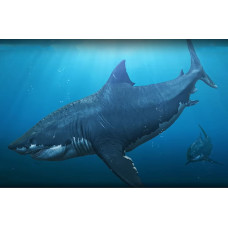Latin name
Otodus megalodon
Other names
Carcharocles megalodon
Identification
Latin Otodus megalodon or Carcharocles megalodon ← Greek μέγας "large" + ὀδούς "tooth". It existed in the Miocene and Pliocene.
Like other sharks, their skeletons were made of cartilage rather than bone. Therefore, any fossil remains of them other than teeth are quite rare. Vertebrae are sometimes found (these, unlike the rest of the skeletal elements, were well mineralized during the shark's lifetime). The cartilaginous skull of Megalodon must have been proportionally thicker and more robust than that of the great white shark, to match the more massive jaws and tooth structure, and to withstand the stresses of use.
Among modern species, the great white shark was once thought to be most similar to Megalodon. However, further studies have shown that the Otodontidae are not closely related to the herring sharks and represent a branch of more primitive sharks that most likely retained the basal features of the Lamniformes. Thus, it is more likely that Megalodon looked like a sandbar shark, and some features of tooth structure that resemble those of the great white shark are more an example of convergent evolution. On the other hand, it is also likely that Megalodon's body shape and features resembled those of a giant shark, since similar proportions are common in large aquatic animals.
Teeth
Megalodon had very strong teeth; their total number reached 276. The teeth were arranged in five rows. According to paleontologists, the size of the jaws of large individuals reached 2 meters. Sufficiently strong but thin teeth of these sharks were serrated with a relatively flat cutting edge. These sharks, due to their size, possessed one of the strongest bites known to science to date, although in relation to the weight of this indicator it was relatively small due to the inferior strength of the bones of the cartilaginous skull.
Features of fish fins
The fins of Megalodon were probably proportionately larger and thicker than the fins of a great white shark, as required for locomotion and motion control of such a massive shark.
Fish colouring
Fossilized Megalodon teeth can range in color from not quite white to dark brown, gray, and blue.
Distribution
Fossil remains suggest that Megalodon were very widespread and abundant. They had a cosmopolitan distribution, and their fossilized remains have been found in many parts of the world, including Europe, Africa, the Americas, and Australia. These sharks were most commonly found in subtropical and temperate latitudes. They have been found as far north as 55° latitude. Their estimated temperature range was 1-24°C (34-75°F). They were probably able to tolerate such low temperatures due to mesothermy, the physiological ability of large sharks to maintain a body temperature higher than the surrounding water by retaining metabolic heat.
Habitat
They inhabited a wide variety of marine environments (e.g., shallow coastal waters, coastal upwelling areas, swampy coastal lagoons, sandy littoral areas, and deep sea areas). Megalodon's lifestyle was erratic. Adult megalodons were rarely found in shallow waters and mostly lived in coastal areas. These sharks were able to move between coastal and oceanic waters, especially during different stages of their life cycle.
Size
The study of fossil remains, represented by a large number of teeth and fossilized vertebrae, shows that this shark had gigantic dimensions, reaching a maximum length of up to 15 meters, according to different estimates, and a maximum weight of 30 to 47 tons. This makes Megalodon one of the largest aquatic predators in the history of our planet.
Behavior
These sharks died out about 3 million years ago. The cause of the extinction, according to biologists, was increased competition with other predators during the nourishment crisis, although previously the most popular version was global climate change. However, some cryptozoologists believe that Megalodon may have survived to the present day. First, studies of two megalodon teeth found accidentally in the Pacific Ocean have shown that they were lost by giant sharks not millions of years ago, but about 24,000 and 11,000 years ago, respectively, which is almost "modern" in terms of geology and paleontology.
Food and feeding habits
They were probably super predators at the top of the food chain. Their teeth marks on marine creatures fossils indicate that they fed on small whales, sirenians, pinnipeds, and large fish, eating them alive or dead. The bite force of the largest individuals could easily open the chest of a small whale.
Reproduction
Megalodon, like its contemporary sharks, used nurseries to give birth to its young, especially in coastal environments with warm water, abundant food, and protection from predators.
Relationship with a person
Megalodon has been depicted in many works of fiction, including movies and novels, and continues to be a popular subject for sea monster-related artwork.
Megalodon teeth are a North Carolina state landmark.
| Classification | |
| Phylum | Chordata |
| Class | Chondrichthyes |
| Squad | Lamniformes |
| Family | Otodontidae |
| Genus | Otodus |
| Species | O. megalodon |
| Features | |
| Conservation status | Extinct |
| Habitat | Pelagic |
| Life span, years | No information |
| Maximum body weight, kg | 47000 |
| Maximum length, cm | 1500 |
| Sailing speed, m/s | No information |
| Threat to people | Not edible |
| Way of eating | Predator |
Megalodon
Tags: megalodon


